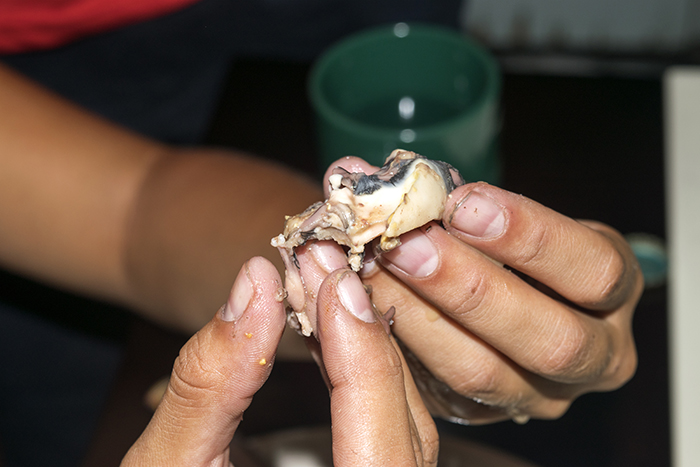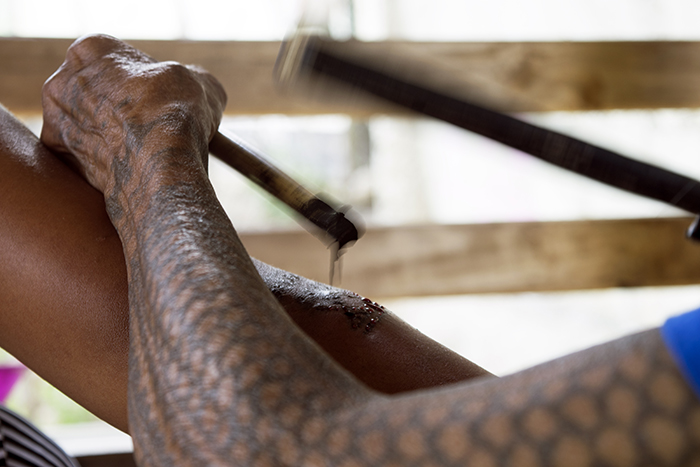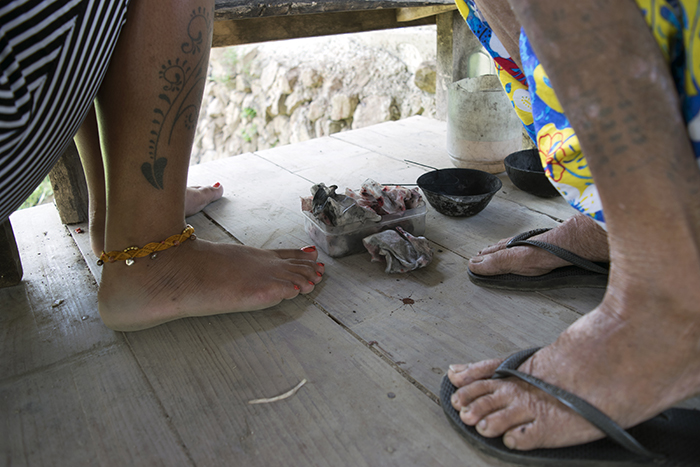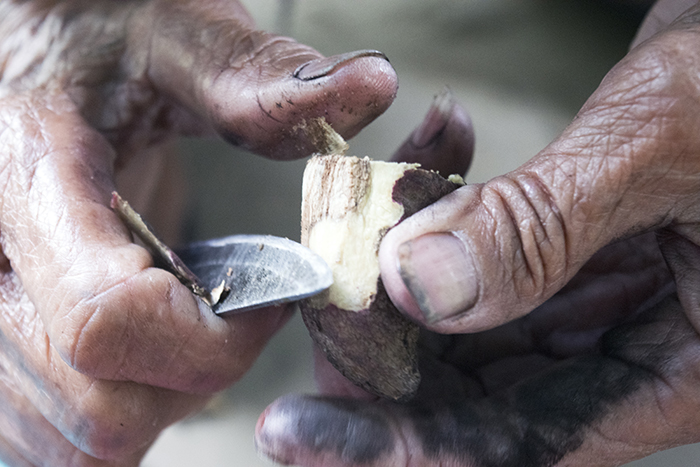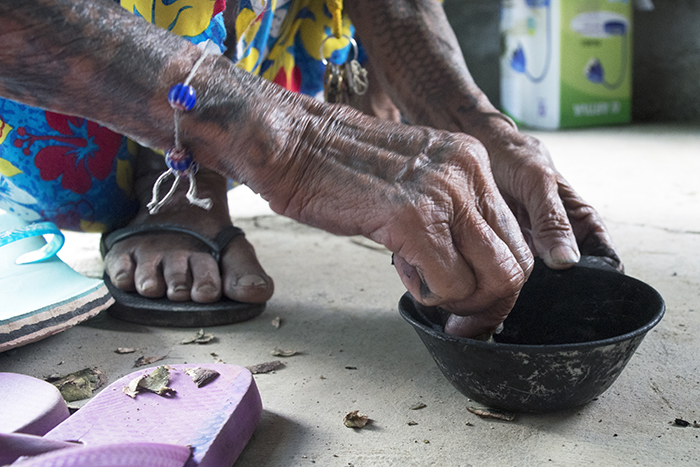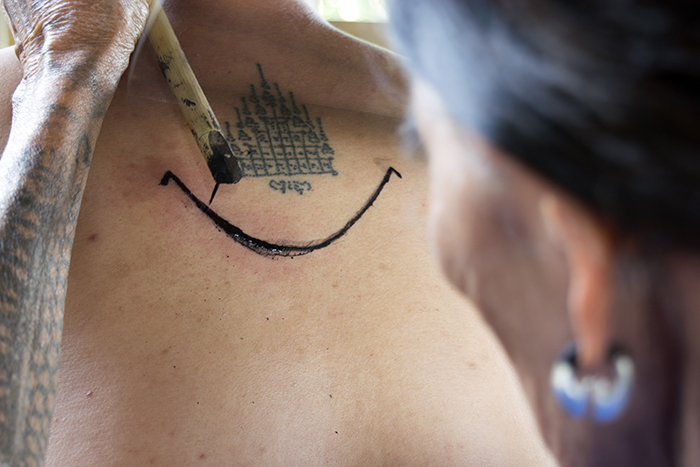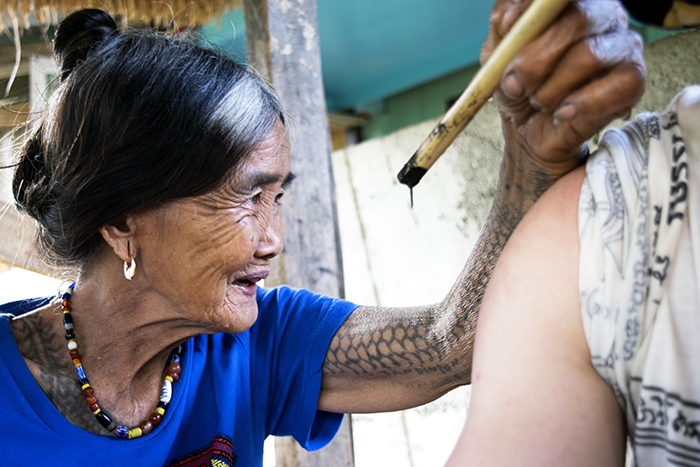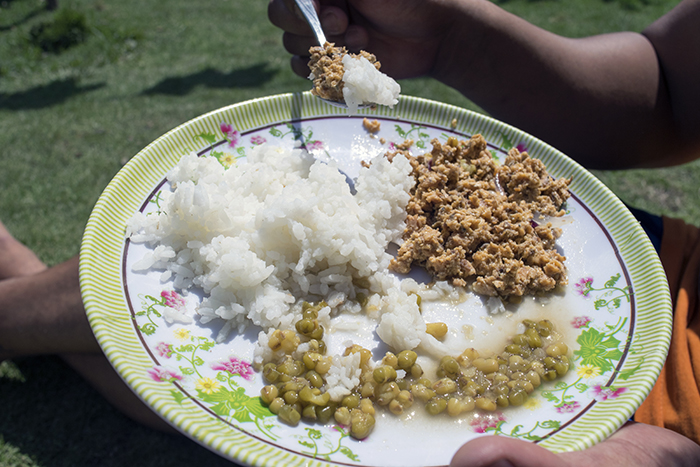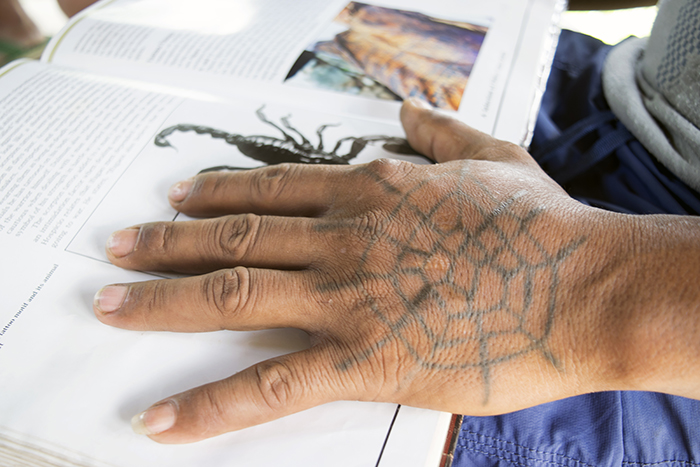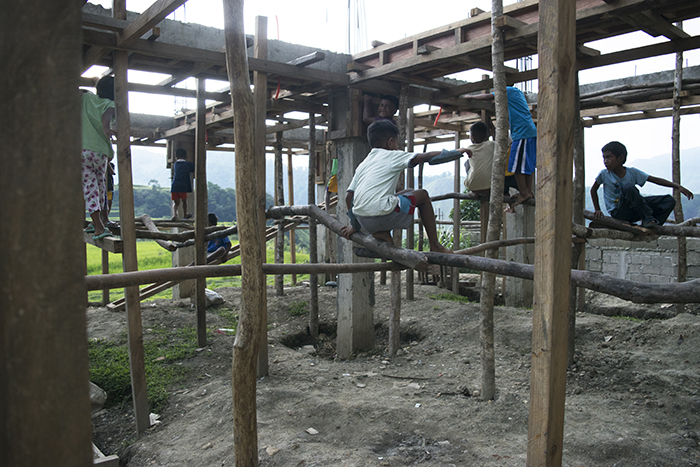Location: Manila, Northern Capital Region, The Philippines
The Opposite of Food Porn: Balut
Location: Manila, Northern Capital Region, The Philippines
Balut is a delicacy of the Philippines, a favorite late-night drunk food, and a must-try for any visitor to the country. But before you get overexcited and buy one from a passing vendor with a thermos full of 'em, be aware that it's a preserved duck fetus. Yeah.
No joke, it's all there. The feathers, the stringy little thigh bones that haven't quite developed yet, and even the beak and eyes. The first night I tried one, I was drunk and it wasn't so bad. But during my attempt to consume the one pictured above, I failed miserably. It was too intense for me (and I enjoy eating weird shit). The key, I've heard, is to get one that's not quite as developed. Then, the fetus is just a ball of black liver-like softness.
It all kind of tastes musty and salty. The white part is flavorless and has the consistency of an old rubber band. It's tough to chew through. The yellow part is soft, like butter. And the duck...it's exactly what you would imagine eating a half-developed bird.
Video: A Moment with the Last of the Mambabatok
Location: Kalinga, The Philippines
Into the Land of the Headhunters, Part IV: Living Artifacts of the Mambabatok
Location: Buscalan Village, Kalinga, The Philippines
In the morning I was awoken by Ralley’s parents. The sun was rising and his mother had prepared potatoes, and rice for breakfast. I brushed my teeth in the outhouse then drank a cup of dark, bitter, sweetened coffee. I was a bit nervous about the pain and about possibly having a bad reaction to the tattoo. You never know, you? There wasn’t a real way to clean it off here except water and it wasn’t like Whang-Od was sterilizing the thorns she used. I wondered if anyone had ever had an infection from it. I’d noticed puppies licking the equipment the day before, but nobody had seemed overly concerned about it.
Craig and Tom’s tattoos looked clean, though, and not swollen at all. There was a bit of crust over each, but they wiped it off and rubbed neosporin over the raised black dot patterns. Richard came to the house to retrieve me and I followed him to Whang-Od’s home. We found her squatting by a fire, cooking pig gruel in a cauldron. I noticed that she slept in a simple twin mattress with an old school squat television set propped against one end.
Seeing her home made me wonder about her life. The villagers had told me she’d had 15 boyfriends over her lifetime, but never a husband. I wondered if she could get married or if her work didn’t allow that. I wanted to ask Richard these questions, but his revere of Whang-Od and the communication barrier made me wary of digging too deep. I didn’t want to offend him by asking what was really on my mind: was Whang-Od happy with her life? It seemed like she was in a position of intense responsibility. Over the past ten years, she’d become a huge source of income for the village, bringing in tourism and fame. When I really thought about it, I realized Richard’s job only existed because of her. That must be a heavy burden to bear, knowing that when you die, everything in your village will change. That you are the last of your kind. Was it a lonely kind of knowledge?
But if Whang-Od felt this way, she rarely showed it. Yesterday, she’d joked with us all, making several playful remarks whether I was dating Craig or Tom (even though I’d explained we were all just travel buddies). She’d also poked at my bee tattoo and asked if it was a fertility symbol.
Richard and I waited while Whang-Od stirred the gruel until she announced that before she began her day’s work, she wanted to get a coffee. Richard explained that Whang-Od didn’t like the village beans but rather preferred the powdered, pre-sweetened Kopiko packets. We decided to go up to the parlor and wait while she went and found herself a coffee.
And then I was sitting on a little stool with Whang-Od behind me, positioned over my right shoulder blade. I could feel her arms hovering just inches over me as she imagined where she wanted to place the design. I pointed to the tattoo from the book and she began her work, dipping a thin straw into the ink. It felt cold when she placed it against my skin. Then, she lifted her hammers into position. I heard the sharp tap of bamboo on bamboo and I felt the first pang of the thorn piercing my skin. And then, the steady rhythm of the clanking sticks and the constant pain as she banged out the design into my back. It really hurt halfway through, when the needle began to stick in my skin. She’d have to tug it loose, popping it back out. I could feel my skin pulling and stretching under her touch.
As she worked, she spoke to Richard, who repeated everything in English.
“Whang-Od says she does not want to tattoo much longer. She wants Grace to take over. This may be one of her last tattoos.”
When she finished, we took a photo together and Whang-Od once again gave me that soul-searching stare, the one that made me wonder about her happiness. I thanked her in Tagalog, but I wasn’t sure she’d understand, so I tried to communicate with my eyes. We ended up staring at each other for a long time.
Afterwards, Craig, Tom, and I headed back down the mountain, caught a jeepney to Bontoc, and then a bus to Baguio. We spent the night there and then took off to Manila the next day, where we all split off in different directions.
Into the Land of the Headhunters, Part III: I Meet Whang-Od
Location: Buscalan Village, Kalinga, The Philippines
When we arrived at the village, Ralley took us to his parents’ house, which sat on the very edge of the mountain, overlooking the whole valley. A bright string of the family’s drying laundry framed one of the most incredible mountain landscapes I’d ever laid eyes on. Rice terraces studded the surrounding cliffs and everything was a hundred different shades of green.
The house itself was decorated with kids’ drawings. A branch of dried marijuana was tacked above the doorway. Two toddlers ran around in the yard while their mother, a young woman nursing an infant at her breast, welcomed us to her home, offering us coffee, which she told us came from beans in her garden. Ralley explained the situation, how he’d found us wandering up here alone. He left and a few minutes later reappeared, behind him a cheery man with a long, thin black beard, who introduced himself as Richard.
Richard spoke excellent English and told us that he was a guide that worked in the village. He’d never met anyone that had come up here unaccompanied. I wondered if we’d overstepped some sort of rule, like that outsiders weren’t allowed in the area without a guide. Nobody seemed angry, though. Instead, Richard was glad to see us. There weren’t any other foreigners in the village at the moment. He pointed to a hut overhanging the steep mountainside visible from Ralley’s yard.
“Whang-Od is up there now. She is tattooing Grace.” Richard said. We all looked up and noticed, if we were quiet, we could hear the soft clink, clink, clink of bamboo hitting bamboo.
“We will go up there and see her and you may get tattoos by the great Whang-Od. But first you must eat.”
Ralley’s mom cooked canned tuna with lentils, rice, and potatoes that she said were all from the village. I thanked her and shoveled down the welcome meal. When we were all full, Richard led the way to Whang-Od’s workshop, which was down a winding path through the village. The closer I came, the louder the ringing of the bamboo sticks became until finally I reached a cement patio area and found myself standing in front of the legendary mambabatok herself.
Her back was turned to me, her silver-and-black hair tied back in a low bun. She squatted low on a tiny stool. On the ground beside her sat little plastic tupperware full of bloody tissues, a dirty bin of calamansi thorns, and a thick, round, black stone mortar coated in ink. A yellow lanyard with keys dangling off the end was wrapped around her head like a handyman’s tiara. She wore bright, baggy pants patterned with Hawaiian flowers and flip flops.
Grace sat on a stool in front of Whang-Od, looking away from the bleeding, swollen lump of her forearm. Ink and blood blended, leaving her arm leaking a dark, thick syrup.
“Whang-Od and Grace! This is Craig, Tom, and Cassia.” Grace turned to us, smiling through her grimace. Though she was now 5 years older than the picture I’d seen of her online, she had the same soft, pretty features.
“Hello!” She said before Whang-Od slapped the sticks together again and her face wrinkled into cringing discomfort. Whang-Od then stopped and turned to look at her new visitors, running her gray-eyed blank gaze over us. When her eyes lingered on me and met mine, I felt my breath choke in my throat. She was the most beautiful, regal woman I’d ever seen. Her face, a maze of wrinkles, held a commanding, delicate natural beauty. She was small and slender, but obviously strong. And she was covered in faded, silver-blue tattoos, and the patterns gave off the same complicated beauty of a Copperhead’s scales, flowing gracefully with her movements. She wore royal blue t-shirt with the red Superman insignia across the front.
Whang-Od said something in the local dialect, nodded, and turned back to her work.
“Whang-Od welcomes you!” Richard said, waving his arm. “Here, you may watch and look at the book of designs.”
Craig, Tom, and I spent the next hour and a half chatting with other locals hanging out in the tattoo parlor, watching Whang-Od decorate Grace’s arm with a badge of beauty. We mulled over the heavy book on traditional tribal tattoos and their meanings. One in particular caught my eye; zigzagged, simple design of lightning. Lightning symbolized two souls in a single body and it reminded me of my own identity: half-Irish, half-Filipina.
When the villagers found out I was half-Filipina, knew a little Tagalog, and had traveled to the Philippines alone to learn about my mother’s homeland, it caused a small uproar. Richard stopped Whang-Od again to tell her. Whang-Od turned to me with those piercing eyes and I felt like she could see through my skin and into my soul. She spoke quietly, her slender, ink-stained fingers still poised around her bamboo needle.
“Whang-Od says you are beautiful.” Richard said. I blushed and said ‘thank you,’ my heart bursting with happiness, knowing that no other compliment could probably ever compare to that moment.
The afternoon went on and Craig and Tom took turns sitting before Whang-Od and receiving the artist’s mark. Craig got the symbol of an eagle tattooed on his back, a dedication to communication and travel. Tom had a scorpion hammered into his shoulder as a mark of strength. I asked Grace for advice on my own tattoo and to my surprise, she opened up the book to the same lightning design I’d pondered earlier.
“It’s of the mountains, the river, and lightning. The river symbolizes Naguilian, where your mother is from. The mountains are Kalinga. And the lightning is dual souls. It means the circle of life. Your mother was born here and left and you have returned to this place, completing the circle.”
I couldn’t have imagined a better tattoo idea to represent this moment in my life.
It was late in the afternoon. After she finished Tom’s tattoo, Whang-Od announced that she was finished with her work for the day. There was not enough light for her to see, anymore. So Tom, Craig, and I made arrangements to stay with Ralley’s family for the night. The next morning at dawn I would come back to the parlor and Whang-Od would tattoo me.
That night turned out to be a celebration. A man, originally from the region and who now lived in Baguio, had returned to visit and receive another tattoo from Whang-Od. He bought a pig to slaughter for the whole village to feast together. Men skinned the pig, and then boiled the meat in a thin broth. Craig, Tom, and I sat in a circle on the floor with the man from Baguio in Whang-Od’s home, Ralley’s father, and Richard. We ate the fatty pork with our fingers, dipping it in broth and scooping it up with balls of rice. We drank the soup from plastic bowls.
Afterwards, we sat in the tattoo parlor overlooking the profiles of the mountains, which were shadowed black under the indigo sky, and we drank beers and sang along as Craig played the villagers’ favorite Bob Marley hits on the guitar.














